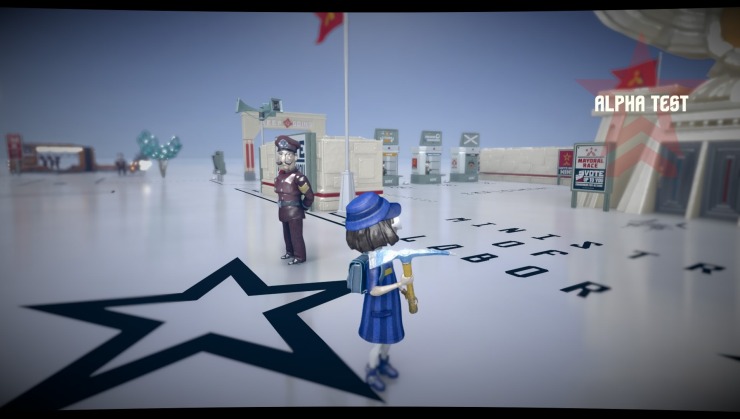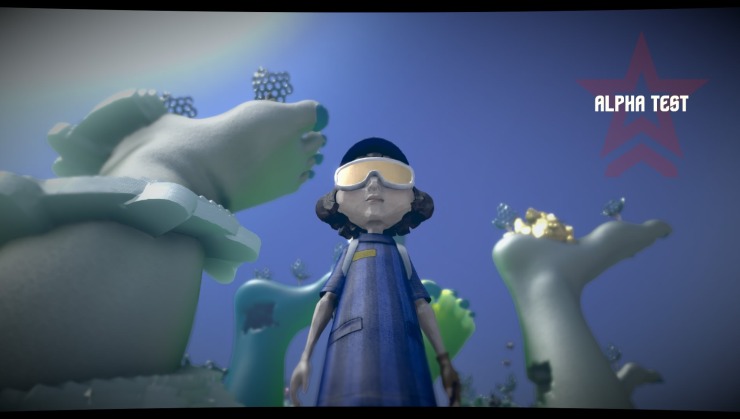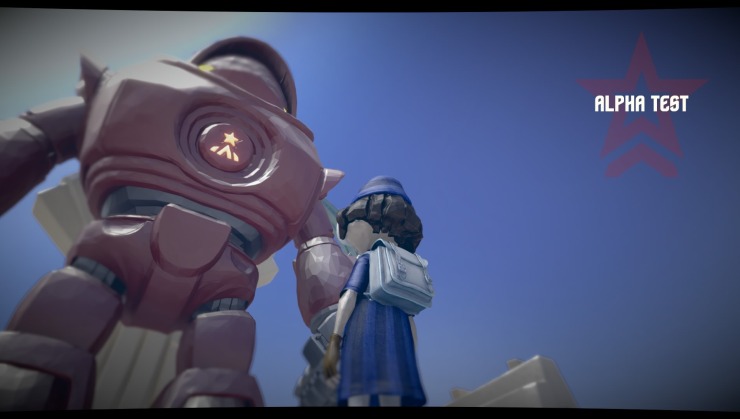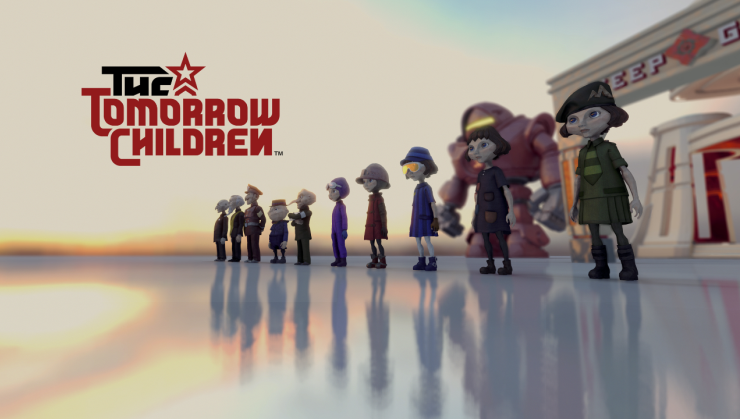What is Q Games’ The Tomorrow Children? The trailer we were treated to at E3 showed a rather bizarre looking game that didn’t really tell us anything about what it is or what you’ll do. Recently, Sony have invited us into the alpha and, as a result, I’ve been playing it and will do my best to explain just what it actually is.
The Tomorrow Children is part tower defence, part multiplayer, part hard labour simulator and it seems like it’s been designed by the team behind Sony’s Puppeteer. The characters in the world look like they’re made from wood, and while the world is generally sparse the objects in it have a rather plasticky sheen to them. It’s all given a sort of dream-like feel in that the areas at the edge of your field of vision are blurred. Everywhere you look in the town you see and hear propaganda. TVs play adverts constantly reminding you of the cause you are serving, and posters are there to motivate you to carry on for the good of the town. There’s something very disquieting about it all though, like all is not as it seems.

You choose one of five classes of dead eyed marionettes – Citizen, Miner, Engineer, Radio Officer and Combatant – each with different stats that will affect their ability to work effectively within the world. Upon spawning for the first time you’re given a pickaxe and told to get to work. Anvil jawed military style personnel watch over you, chivvying you up or offering tips as to what you should do. Basically, you just have to get on with the back-breaking labour.
So, off you go to one of two islands, and get mining. As you hack away at the rock you’ll come across metals, crystals and other objects that can be taken back to the town and added to the ever growing pile of materials that can be used to build items and provide power, among other things. What you’re really after though are Matroshka dolls, which when delivered to the Rescue Apparatus (a large counting screen in the town) will resurrect humans that have been lost to what is referred to as the Void. Achieving a high enough population level is how your town will succeed.
Once your pickaxe is broken you’ll realise you’ll need to buy another one, but how? Well, in the centre of town there is a kiosk: go and queue (yes, you need to queue), and when it’s your turn your contributions are tallied, and you are given ration coupons, money and experience. Ration coupons and money are used to buy tools, while experience unsurprisingly grants you points to assign to your stats to enable you to work more efficiently.

Tools you can buy include a chainsaw to cut down trees, shovels to dig, the already mentioned pickaxe, a Jackrammer that creates platforms, stepladders, shotguns and a host of other things. You can buy these from the kiosks in town with ration coupons, or if you’re at a mining site you can purchase slightly better versions from the Black Market using money. This at least alleviates the to-ing and fro-ing of going to town when your current tool breaks. Money is scarce though, so spending it frivolously isn’t wise when you can instead purchase items with your ration coupons, which are much easier to come by.
The town is attacked at regular intervals by a range of monsters – ranging from small wasp like drones to hulking giants – called the Izverg. Defending the town is a case of either jumping on a turret and firing at the approaching enemies or going to the shop and buying a shotgun. The smaller enemies will attack you, while larger ones will destroy buildings. Failure to prevent the town from being overrun will mean the town is lost to the void and you will need to move to the next one and begin again.
As well as using tools to gather resources, trees can be shaken to gain apples, treadmills can be run on to generate power (by way of a mini-game) or you can use the workbench to build items to further the progress of the town. All actions will contribute to ration coupons earned; the more you do, the more you’ll get. As resources flood in, the town gets bigger, buildings appear, defences are added and more NPCs crop up. I left one night, came back the next day and the town had a giant robot, although I never did get to see it in action.

There’s a day night cycle to be aware of too. Being in darkness whether inside an island or when night-time falls will result in your avatar taking damage – too long and you will perish. Any light source at this time is a saviour, whether it’s going outside into the sunlight, or making sure you’re working near a lantern or one of the strange glowing flowers that sparsely populate the islands. You’re given a warning when the sun is setting, it comes well in advance of the encroaching darkness, so you have more than enough time to make sure you aren’t in danger.
The town is surrounded by water, the border of which you cannot see. Many times I died through wandering into it and drowning before I could get back out. The problem here is that the water is the same colour as the ground, meaning that you can’t tell where it starts and the ground ends. You can build a bridge over it, but there’s no way to know that you’re back over land, so you never know when it’s safe to stop building and get down. It should be noted that this is an alpha though, and as such this may be rectified in the final product.
There’s something relaxing about it all: you’re not penalised for doing nothing, but not contributing will result in your not gaining anything. Even death – while it will cost you ration coupons – is relatively painless. Any items you mine or return to town belong to the town, not you, so you’re part of a collective no matter how much effort you put in.
At the end of all this though, The Tomorrow Children is still something that I am struggling to define adequately. What this highlights is that once again Sony is willing to take a punt on something different. Considering the industry’s love for games that are willing to try new things, this is a title that could very well gain a following.






